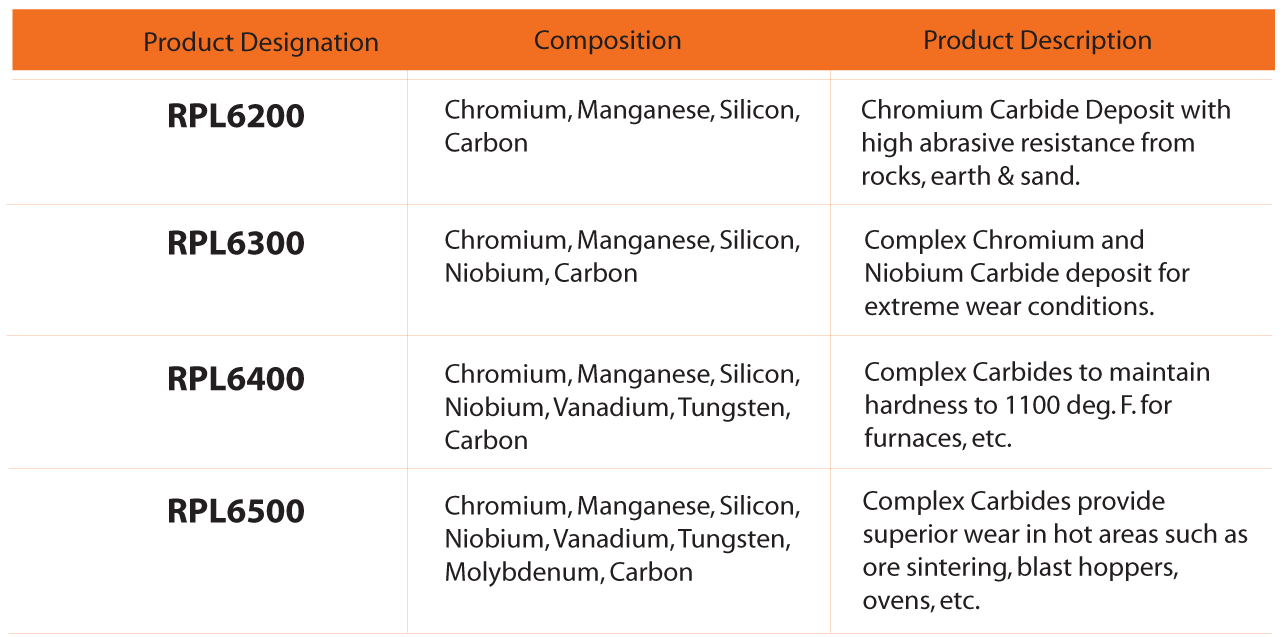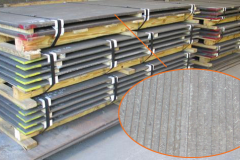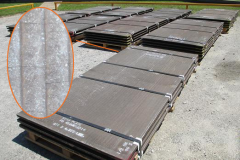Rock Plate, manufactured in the USA, is a composite wear plate consisting of a high chromium carbide weld overlay applied to an A36 carbon steel (most common) base plate. The chromium carbide weld overlay is used for its corrosion, severe abrasion and moderate impact features. Rock Plates chromium carbide weld wire is manufactured to Nibrock, Inc.’s proprietary specifications and is applied with the FCAW (Automatic / Semi-Automatic) Welding Process. With the selection of the A36 carbon steel base plate that provides for the ductility and weld ability that is ideal for shop fabrication and field installation, the unique characteristic of Rock Plate is completed.
Nibrock, Inc.’s common types of Rock Plate produced:

* Custom alloys of plate base metal and weld overlay are available upon request
Nibrock, Inc. currently has four custom built 9’x 13’ / 5-Head Automated Plate Tables with the capability of producing chromium carbide Rock Plate in stock sizes up to 8’ Wide x 12’ Long. Rock Plate is produced with oscillated weave welds and has a weld penetration into base metal of 1/32” Min. / 3/32” Max.
Standard Rock Plate Thicknesses consist of:
- 1/8” Overlay on 1/4”, 5/16”, 3/8” & 1/2″ Base Metal (Single Pass)
- 1/4″ Overlay on 1/4″, 3/8”, 1/2″, 5/8” & 3/4″ Base Metal (Single Pass)
- 1/4″ Overlay on 1/4″, 5/16”, 3/8”, 1/2″, 5/8” & 3/4″ Base Metal (Double Pass)
- 3/8” Overlay on 3/8”, 1/2″, 5/8” & 3/4” Base Metal (Double Pass)
- 1/2″ Overlay on 1/2″, 3/4″ & 1” Base Metal (Double Pass)
* Custom weld overlay & base metal thicknesses are available upon request
* Chromium carbide overlay thickness cannot exceed base metal thickness

Typical Chromium Carbide Wire Chemistry (Undiluted)
- Carbon: 6.50 %
- Manganese: 2.50 %
- Silicon: 1.25 %
- Chromium: 30.00 %
Appearance
- The chromium carbide overlay surface of Rock Plate will consist of oscillated weave weld beads that varies in width depending on the thickness of the Rock Plate being produced. Numerous hairline type stress relief cracks will appear every 1/2″ to 2” apart on the chromium carbide overlay surface during the welding process. These stress relief cracks, being a natural characteristic of chromium carbide overlay, do not penetrate into the base metal material.
Cutting
- Plasma, laser, water jet or abrasive saw are the recommended methods for cutting Rock Plate
- Rock Plate cannot be cut by oxy-fuel
- When cutting Rock Plate, cut from the base material side into the chromium carbide overlay side in order not to contaminate chromium carbide into the base material
Machining / Grinding
- Machining of Rock Plate can only be achieved by Blanchard Grinding.
- General clean-up of Rock Plate from shape-cut plates, holes, bevels or any other non-precision removal of the chromium carbide overlay can be achieved by grinding with a hard-grit, soft bond wheel.
Forming
- Rock Plate can be formed to a radius of 10x’s the material thickness with the overlay on the ID side and using proper forming methods
Straight / Flatness
- Rock Plate has a flatness tolerance of +/- 1/8” over 5’- 0”
- Nibrock, Inc. prides itself on having Rock Plate as one of the flattest chromium carbide overlay plates in the market today.

